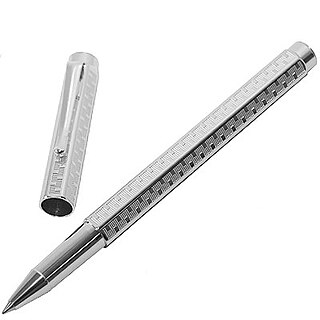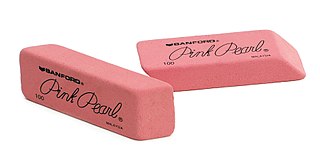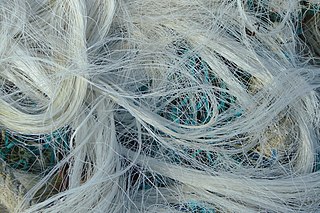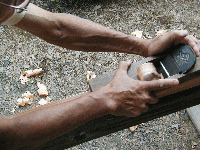
Trolling is a method of fishing where one or more fishing lines, baited with lures or bait fish, are drawn through the water at a consistent, low speed. This may be behind a moving boat, or by slowly winding the line in when fishing from a static position, or even sweeping the line from side-to-side, e.g. when fishing from a jetty. Trolling is used to catch pelagic fish such as salmon, mackerel and kingfish.

A pen is a common writing instrument that applies ink to a surface, usually paper, for writing or drawing. Early pens such as reed pens, quill pens, dip pens and ruling pens held a small amount of ink on a nib or in a small void or cavity that had to be periodically recharged by dipping the tip of the pen into an inkwell. Today, such pens find only a small number of specialized uses, such as in illustration and calligraphy. Reed pens, quill pens and dip pens, which were used for writing, have been replaced by ballpoint pens, rollerball pens, fountain pens and felt or ceramic tip pens. Ruling pens, which were used for technical drawing and cartography, have been replaced by technical pens such as the Rapidograph. All of these modern pens contain internal ink reservoirs, such that they do not need to be dipped in ink while writing.

A broadaxe is a large broad-headed axe. There are two categories of cutting edge on broadaxes, both are used for shaping logs into beams by hewing. On one type, one side is flat, and the other side beveled, a basilled edge, also called a side axe, single bevel, or chisle-edged axe. On the other type, both sides are beveled, sometimes called a double bevel axe, which produces a scalloped cut.

In woodworking, hewing is the process of converting a log from its rounded natural form into lumber (timber) with more or less flat surfaces using primarily an axe. It is an ancient method, and before the advent the sawmills, it was a standard way of squaring up wooden beams for timber framing. Today it is still used occasionally for that purpose by anyone who has logs, needs beams, and cannot or would prefer not to pay for finished lumber. Thus, homesteaders on frugal budgets, for example, may hew their own lumber rather than buy it.
A straightedge or straight edge is a tool used for drawing straight lines, or checking their straightness. If it has equally spaced markings along its length, it is usually called a ruler.

A spirit level, bubble level, or simply a level, is an instrument designed to indicate whether a surface is horizontal (level) or vertical (plumb). Two basic designs exist: tubular and bull's eye . Different types of spirit levels may be used by carpenters, stonemasons, bricklayers, other building trades workers, surveyors, millwrights and other metalworkers, and in some photographic or videographic work.

An eraser is an article of stationery that is used for removing marks from paper or skin. Erasers have a rubbery consistency and come in a variety of shapes, sizes, and colors. Some pencils have an eraser on one end. Erasers can come in various shapes and colors. Less expensive erasers are made from synthetic rubber and synthetic soy-based gum, but more expensive or specialized erasers are made from vinyl, plastic, or gum-like materials.

A combination square is a multi-purpose measuring and marking tool used in metalworking, woodworking, and stonemasonry. It is composed of a rule and one or more interchangeable heads that can be attached to the rule. Other names for the tool include adjustable square, combo square, and sliding square.

The steel square is a tool used in carpentry. Carpenters use various tools to lay out structures that are square, many of which are made of steel, but the name steel square refers to a specific long-armed square that has additional uses for measurement, especially of various angles. It consists of a long, wider arm and a shorter, narrower arm, which meet at an angle of 90 degrees. Today the steel square is more commonly referred to as the framing square or carpenter's square, and such squares are no longer invariably made of steel ; they can also be made of aluminum or polymers, which are light and resistant to rust.

Monofilament fishing line is fishing line made from a single fiber of plastic material, as opposed to multifilament or braided fishing lines constructed from multiple strands of fibers. Most fishing lines are now nylon monofilament because they are cheap to manufacture and can be produced in a range of diameters which have different tensile strengths. Monofilament line is also available in different colors, such as clear, white, green, blue, red, and fluorescent.

A scriber is a hand tool used in metal work to mark lines on workpieces, prior to machining. The process of using a scriber is called scribing and is just part of the process of marking out. It is used instead of pencils or ink lines, because the latter are hard to see, easily erased, and imprecise due to their wide mark; scribe lines are thin and semi-permanent. On non-coated workpieces marking blue is commonly used to increase the contrast of the mark lines.
Marking out or layout means the process of transferring a design or pattern to a workpiece, as the first step in the manufacturing process. It is performed in many industries or hobbies although in the repetition industries the machine's initial setup is designed to remove the need to mark out every individual piece.

Japanese carpentry was developed more than a millennium ago that is known for its ability to create everything from temples to houses to tea houses to furniture by wood with the use of few nails.

The Japanese plane or kanna (鉋) is a plane pulled towards the user rather than pushed in the manner of western style planes. They are made of hardwood, usually Japanese white or red oak. The laminated steel and iron blade is stout compared to western planes. Tapered in length and thickness, the plane blade is its own wedge, as it fits into a correspondingly-shaped mortice in the body of the plane, thus dispensing the need for a separate wedge to hold the blade in place, as is the case in most other traditional wooden planes. The chip breaker is held in place with a simple nail inserted some distance away from and perpendicular to the axis of the main blade. The chip breaker is not tapered like the main blade; instead, it has bent "ears" that bear down on the plane blade. Chip breakers in Japan were introduced relatively recently, during the Meiji period. The soles of Japanese planes also have different configurations for varying applications. The apparently simple design disguises a great deal of complexity.
Although an antique tool might be said to be one that is more than a hundred years old, the term is often used to describe any old tool of quality that might be deemed collectable.
This glossary of woodworking lists a number of specialized terms and concepts used in woodworking, carpentry, and related disciplines.

A carpenter pencil is a pencil that has a body with a rectangular or elliptical cross-section to allow it to be used as a quick reference to 1/4 and 1/2 inch measurements. The shape also helps prevent it from rolling away as a secondary function. Carpenter pencils are easier to grip than standard pencils, because they have a larger surface area. The non-round core allows thick or thin lines to be made by holding the pencil slightly rotated, particularly useful in carpentry where thin lines are required for high precision markings and are easy to erase, but thick markings are needed to mark on rough surfaces. The pencil is robust and strong to endure heavy duty environments like a tool box, construction site, or carpentry shop. The core is typically stronger than in other pencils. As such, carpenter pencils are often used by builders because they can mark on surfaces like concrete or stone. The shape and lead density aid in marking legible lines with a straight edge that are clear and easy to follow with a saw blade. Carpenter pencils are typically manually sharpened with a knife, although special sharpeners can be used.
Graphotype was a process of autographic engraving by which typographic printing blocks were produced.

String is a long flexible structure made from fibers twisted together into a single strand, or from multiple such strands which are in turn twisted together. String is used to tie, bind, or hang other objects. It is also used as a material to make things, such as textiles, and in arts and crafts. String is a simple tool, and its use by humans is known to have been developed tens of thousands of years ago. In Mesoamerica, for example, string was invented some 20,000 to 30,000 years ago, and was made by twisting plant fibers together. String may also be a component in other tools, and in devices as diverse as weapons, musical instruments, and toys.
















